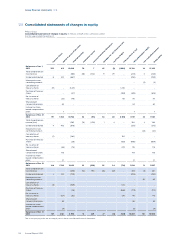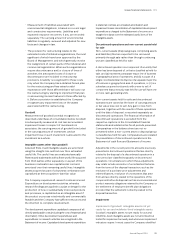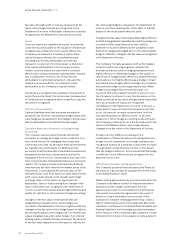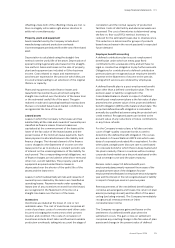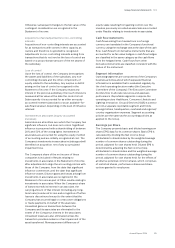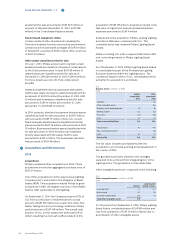Philips 2014 Annual Report Download - page 121
Download and view the complete annual report
Please find page 121 of the 2014 Philips annual report below. You can navigate through the pages in the report by either clicking on the pages listed below, or by using the keyword search tool below to find specific information within the annual report.Group nancial statements 12.9
Annual Report 2014 121
monetary items in a foreign currency that are measured
based on historical cost are translated using the exchange
rate at the transaction date.
Foreign operations
The assets and liabilities of foreign operations,
including goodwill and fair value adjustments arising on
acquisition, are translated to euro at exchange rates at
the reporting date. The income and expenses of foreign
operations are translated to euro at exchange rates at
the dates of the transactions.
Foreign currency dierences arising on translation of
foreign operations into euro are recognized in Other
comprehensive income, and presented as part of
Currency translation dierences in Equity. However, if
the operation is a non-wholly owned subsidiary, then
the relevant proportionate share of the translation
dierence is allocated to Non-controlling interests.
When a foreign operation is disposed of such that
control, signicant inuence or joint control is lost, the
cumulative amount in the Currency translation
dierences related to the foreign operation is
reclassied to the Statement of income as part of the
gain or loss on disposal. When the Company disposes
of only part of its interest in a subsidiary that includes
a foreign operation while retaining control, the
respective proportion of the cumulative amount is
reattributed to Non-controlling interests. When the
Company disposes of only part of its investment in an
associate or joint venture that includes a foreign
operation while retaining signicant inuence or joint
control, the relevant proportion of the cumulative
amount is reclassied to the Statement of income.
Financial instruments
Non-derivative nancial instruments
Non-derivative nancial instruments are recognized
initially at fair value when the Company becomes a
party to the contractual provisions of the instrument.
Regular way purchases and sales of nancial
instruments are accounted for at the trade date.
Dividend and interest income are recognized when
earned. Gains or losses, if any, are recorded in Financial
income and expense.
Non-derivative nancial instruments comprise cash
and cash equivalents, receivables, other non-current
nancial assets, debt and other nancial liabilities that
are not designated as hedges.
Cash and cash equivalents
Cash and cash equivalents include all cash balances
and short-term highly liquid investments with an
original maturity of three months or less that are readily
convertible into known amounts of cash.
Receivables
Receivables are carried at the lower of amortized cost
or the present value of estimated future cash ows,
taking into account discounts given or agreed. The
present value of estimated future cash ows is
determined through the use of value adjustments for
uncollectible amounts. As soon as individual trade
accounts receivable can no longer be collected in the
normal way and are expected to result in a loss, they
are designated as doubtful trade accounts receivable
and valued at the expected collectible amounts. They
are written o when they are deemed to be
uncollectible because of bankruptcy or other forms of
receivership of the debtors. The allowance for the risk
of non-collection of trade accounts receivable takes
into account credit-risk concentration, collective debt
risk based on average historical losses, and specic
circumstances such as serious adverse economic
conditions in a specic country or region.
Other non-current nancial assets
Other non-current nancial assets include held-to-
maturity investments, loans and available-for-sale
nancial assets and nancial assets at fair value
through prot or loss.
Held-to-maturity investments are those debt securities
which the Company has the ability and intent to hold
until maturity. Held-to-maturity debt investments are
recorded at amortized cost, adjusted for the
amortization or accretion of premiums or discounts
using the eective interest method.
Loans receivable are stated at amortized cost, less
impairment.
Available-for-sale financial assets are non-derivative
financial assets that are designated as available-for-sale and
that are not classified in any of the other categories of
financial assets. Subsequent to initial recognition, they are
measured at fair value and changes therein, other than
impairment losses and foreign currency differences on
available for sale-debt instruments are recognized in Other
comprehensive income and presented in the fair value
reserve in equity. When an investment is derecognized, the
gain or loss accumulated in equity is reclassified to the
Statement of income.
Available-for-sale nancial assets including
investments in privately-held companies that are not
associates, and do not have a quoted market price in an
active market and whose fair value could not be reliably
determined, are carried at cost.
A nancial asset is classied as fair value through prot
or loss if it is classied as held for trading or is
designated as such upon initial recognition. Financial
assets are designated as fair value through prot or loss
if the Company manages such investments and makes
purchase and sale decisions based on their fair value in
accordance with the Company’s documented risk
management or investment strategy. Financial assets at





